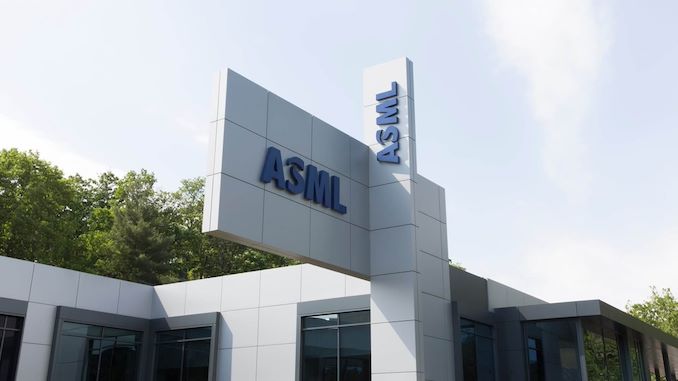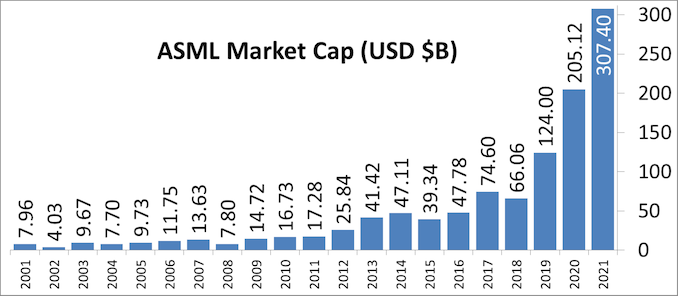Intel's Process Roadmap to 2025: with 4nm, 3nm, 20A and 18A?!
by Dr. Ian Cutress on July 26, 2021 5:00 PM ESTSidebar on Intel EUV
In all of these announcements, one thing to highlight is Intel mentioning its relationship with ASML, the sole company that manufactures the EUV machines powering production of leading edge semiconductor manufacturing.
ASML is a unique company in that it is the only one that can produce these machines, because the technology behind them is often tied up with its partners and research, but also because all the major silicon manufacturers are heavily invested in ASML. For any other company to compete against ASML would require building a separate network of expertise, a decade of innovation and design, and a lot of capital. None of the major silicon vendors want to disturb this balance and go off on their own, lest it shuts them out of the latest manufacturing technology, and no research fund sees competing against the embedded norm as a viable opportunity. This means that anyone wanting EUV specialist technology has to go to ASML.
In 2012, it was reported that Intel, Samsung, and TSMC all invested in ASML. This was, at the time, to jumpstart EUV development along with migrating from 300mm wafers to 450mm wafers. While we haven’t moved to 450mm wafers yet (and there are doubts we will any time in the next decade), EUV is now here. Intel’s 2012 investment of $2.1 billion gave them a 10% stake in ASML, with Intel stating that it would continue investing up to a 25% stack. Those stakes are now below the 5% reporting threshold, but all three of the major foundry customers are still big owners, especially as ASML’s market cap has risen from $24 Billion in 2012 to $268 Billion in 2021 (surpassing Intel).
As major investors but also ASML’s customers, the race has been on for these foundries to acquire enough EUV machines to meet demand. TSMC reported in August 2020 that it has 50% of all EUV machines manufactured at ASML for its leading edge processes. Intel is a little behind, especially as none of Intel’s products in the market yet use any EUV. EUV will only intercept Intel’s portfolio with its new Intel 4 process, where it will be used extensively, mostly on the BEOL. But Intel still has to order machines when they need them, especially as there are reports that ASML currently has backorders of 50 EUV machines. In 2021, ASML is expected to manufacture around 45-50 machines, and 50-60 in 2022. The exact number of machines Intel has right now, or has ordered from ASML, is unknown. It is expected that each one has a ~$150m price tag, and can take 4-6 months to install.
With all that being said, Intel’s discussion point today is that it will be the lead customer for ASML’s next generation EUV technology known as High-NA EUV. NA in this context relates to the ‘numerical aperture’ of the EUV machine, or to put simply, how wide you can make the EUV beam inside the machine before it hits the wafer. The wider the beam before you hit the wafer, the more intense it can be when it hits the wafer, which increases how accurately the lines are printed. Normally in lithography to get better printed lines, we move from single patterning to double patterning (or quad patterning) to get that effect, which decreases yield. The move to High-NA would mean that the ecosystem can stay on single patterning for longer, which some have quoted as allowing the industry to ‘stay aligned with Moore’s Law longer’.
| ASML's EUV Shipments | |||||||||||||||||||||
| 2015 | 2016 | 2017 | 2018 | 2019 | 2020 | 2021 | |||||||||||||||
| Actual | 2 | 4 | 10 | 3 | 4 | 5 | 6 | 4 | 7 | 7 | 8 | 4 | 7 | 14 | 8 | 7 | 9 | - | - | ||
| Target (Total) | - | - | - | 20 (18) | 30 (26) | 35 (33) | 45-50 | ||||||||||||||
| 2018 and beyond is split per quarter for actual shipped numbers Data taken from ASML's Financial Reports |
|||||||||||||||||||||
Current EUV systems are NA 0.33, while the new systems are NA 0.55. ASML’s latest update suggests that it expects customers to be using High-NA for production in 2025/2026, which means that Intel is likely going to be getting the first machine (ASML NXE:5000 we think) in mid-2024. Exactly how many High-NA machines ASML intends to produce in that time frame is unknown, as if they flood the market, having the first won’t be a big win. However if there is a slow High-NA ramp, it will be up to Intel to capitalize on its advantage.













326 Comments
View All Comments
throAU - Tuesday, July 27, 2021 - link
as an ice lake laptop user it may have been a shipping product, but it’s crap. hot, noisy, outperformed by my 3 year old ipad pro.nico_mach - Tuesday, July 27, 2021 - link
This is the key thing. The article concludes that Intel 10nm=industry's 7nm, but performance of the actual chips (CPUs and also GPUs) are night and day different. It doesn't match up to reality. Which doesn't mean that Intel/article are wrong, but it needs some explaining if the x86 instruction set or Windows/Android/NVIDIA/AMD are the culprits or what. Everyone using Mac laptops through the years knows what the reality is. Same with AMD vs Intel on the desktop in the last couple years.mode_13h - Wednesday, July 28, 2021 - link
> The article concludes that Intel 10nm=industry's 7nmUm, did you read it? Because they didn't *completely* lay this out, but Intel is projected to have 4 full iterations of 10 nm, by the time they move to a higher density. The first was Cannon Lake, Ice Lake was second (10 nm+), Tiger Lake (10 nm SF) is 3rd, and Alder Lake (10 nm ESF - now Intel 7) is to be the 4th. There are significant performance and efficiency changes between each.
Amandtec - Tuesday, July 27, 2021 - link
The wheels fell off because they thought the could continue to shrink without EUV including buying expensive ASML machines that have limited supply and take long from order to delivery. Once they realized their error they were stranded. Note that this is just inferred as a reasonable explanation from what transpired - there is no hard proof of this, so the real cause may be something else.Spunjji - Thursday, July 29, 2021 - link
One thing we can reliably infer is that the solutions involved decreasing density in shipping products and (initially, at least) accepting abysmal yields. For example, even now, they still talk about wafers when they talk about finally producing more 10nm than 14nm... but wafers are input, not output.FreckledTrout - Monday, July 26, 2021 - link
20Å ~= 20 AmpsIntel please change it to 20Å as it looks cooler and isn't as confusing.
regsEx - Monday, July 26, 2021 - link
99% of users in this World have no this letter on their keyboardsAshinjuka - Monday, July 26, 2021 - link
ALT+143 is literally how I typed this: Åikjadoon - Monday, July 26, 2021 - link
Å, well bam, there ya.Amandtec - Tuesday, July 27, 2021 - link
That is four letters so regsEx is right. Still is would be pretty CÖÖL!